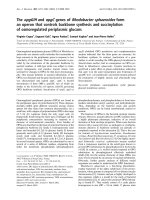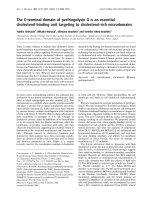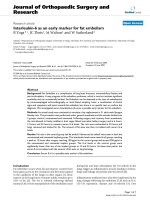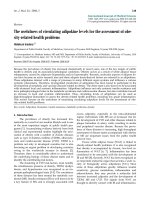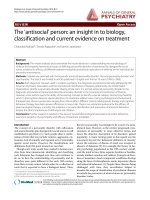Báo cáo y học: "The Amborella genome: an evolutionary reference for plant biolog" docx
Bạn đang xem bản rút gọn của tài liệu. Xem và tải ngay bản đầy đủ của tài liệu tại đây (248.56 KB, 6 trang )
Genome
BBiioollooggyy
2008,
99::
402
Correspondence
TThhee
AAmmbboorreellllaa
ggeennoommee:: aann eevvoolluuttiioonnaarryy rreeffeerreennccee ffoorr ppllaanntt bbiioollooggyy
Douglas E Soltis
1
, Victor A Albert
2,3
, Jim Leebens-Mack
4
,
Jeffrey D Palmer
5
, Rod A Wing
6
, Claude W dePamphilis
7
, Hong Ma
7
,
John E Carlson
8
, Naomi Altman
9
, Sangtae Kim
10
, P Kerr Wall
7
,
Andrea Zuccolo
6
and Pamela S Soltis
11
Addresses:
1
Department of Botany and the Genetics Institute, University of Florida, Gainesville, FL 32611, USA.
2
Joint Centre for
Bioinformatics in Oslo, University of Oslo and Rikshospitalet HF, Blindern, NO-0316 Oslo, Norway.
3
Department of Biological Sciences,
University at Buffalo (SUNY), Buffalo, NY 14260-1300, USA.
4
Department of Plant Biology, University of Georgia, Athens, GA 30602, USA.
5
Department of Biology, Indiana University, Bloomington, IN 47405, USA.
6
Department of Plant Sciences, University of Arizona, Tucson, AZ
85721, USA.
7
Department of Biology, the Huck Institutes of the Life Sciences, and the Institute of Molecular Evolutionary Genetics,
Pennsylvania State University, University Park, PA 16802, USA.
8
School of Forest Resources, Pennsylvania State University, University
Park, PA 16802, USA.
9
Department of Statistics, Pennsylvania State University, University Park, PA 16802, USA.
10
National Institute of
Biological Resources, Incheon 404-170, Korea.
11
Florida Museum of Natural History and the Genetics Institute, University of Florida,
Gainesville, FL 32611, USA.
Correspondence: Pamela S Soltis. Email:
Published: 10 March 2008
Genome
BBiioollooggyy
2008,
99::
402 (doi:10.1186/gb-2008-9-3-402)
The electronic version of this article is the complete one and can be
found online at />© 2008 BioMed Central Ltd
The origin and evolution of the angio-
sperms is one of the great terrestrial
radiations and has had manifold effects
on the global biota. Today, flowering
plants generate the vast majority of
human food, either directly or indirectly
as animal feed, and account for a huge
proportion of land-based photosyn-
thesis and carbon sequestration. With a
fossil record that extends back to just
over 130 million years ago, flowering
plants have diversified to include
250,000 to possibly 400,000 species
occupying nearly every habitable terres-
trial environment, and many aquatic
ones. Understanding how angiosperms
have accomplished this feat over a
relatively short span of evolutionary
time will elucidate many of the key
processes underlying the assembly of
Earth’s plant/animal associations and
entire ecosystems.
Many scientists have understood the
importance of broad, comparative
genome sequencing since the beginning
of the Arabidopsis thaliana and rice
(Oryyza sativa) genome sequencing
projects [1-4]. Arabidopsis, a relative of
cabbage, had already become the
premier model for plant genetics, and
half the world’s dependence on rice for
food makes that crop plant an impor-
tant model for the genetic architecture
of traits important to humanity. More
recently, poplar (Populus trichocarpa),
grapevine (Vitis vinifera) and papaya
(Carica papaya) have been sequenced
as genomic models for woody crop
plants [5-12]. These advances have been
motivated by the realization that
understanding the structure and
evolution of plant genomes would
contribute to society through enhance-
ments to agriculture and forestry [13].
However, the few angiosperm nuclear
genomes that have been sequenced so
far reside on just two limbs within the
angiosperm branch of the Tree of Life
[14,15] and, therefore, aid us little in
understanding the characteristics of the
last common ancestor of all angio-
sperms (Figure 1). Many key angiosperm
innovations, such as the origin of the
flower and fruit, diverse pollination
systems and double fertilization, large
water-conducting vessel elements,
diverse biochemical pathways, and
many of the specific genes that regulate
AAbbssttrraacctt
The nuclear genome sequence of
Amborella trichopoda
, the sister species to all other extant
angiosperms, will be an exceptional resource for plant genomics.
key growth and developmental proces-
ses, appeared first among the basal angio-
sperm lineages [16-20]. A thorough
understanding of processes that shape
genes and genomic features, and of the
many similarities and differences between
model monocots (for example, Oryza)
and eudicots (for example, Arabidopsis),
requires a perspective based on evo-
lutionary lineages. Such perspectives
can be obtained only through analysis
of an appropriately broad sampling of
genomes, including lineages branching
from the most basal node on the
angiosperm tree [21]. But which basal
angiosperm(s) should be given the
highest priority for sequencing in the
near future?
Recent phylogenetic analyses [14,15,17,
22] have identified Amborella tricho-
poda, a large shrub known only from
the island of New Caledonia, as the
single ‘sister species’ to all other living
flowering plants. Amborella therefore
offers the unparalleled potential to
‘root’ analyses of all angiosperm
features, from gene families to genome
structure, and from physiology to mor-
phology. Furthermore, as the branch-
ing-point for Amborella is situated
‘between’ gymnosperms and all other
angiosperms, a genome sequence for
Amborella would help characterize
processes that distinguish these two
lineages of extant seed plants. The
nuclear genome sequence of Amborella
would contribute uniquely to efforts to
reconstruct characteristics of the
‘ancestral angiosperm’. The importance
of Amborella in this regard is already
widely appreciated [19,23]. Two recent
papers, in fact, point specifically to
basal angiosperms, including Amborella,
as obvious choices for future nuclear
genome sequencing efforts [24,25].
The genome structure of the ancestral
angiosperm is currently much debated:
did a whole-genome duplication pre-
date or coincide with the origin of angio-
sperms (perhaps catalyzing innovation)
or did the whole-genome duplication
reported for several lineages of basal
angiosperms [26] occur after the
/>Genome
BBiioollooggyy
2008, Volume 9, Issue 3, Article 402 Soltis
et al.
402.2
Genome
BBiioollooggyy
2008,
99::
402
FFiigguurree 11
The position of
Amborella
in the angiosperm phylogenetic tree. Taxa for which whole-genome sequences have been published are indicated in
parentheses. The node highlighted by a star on the tree identifies the ‘ancestral angiosperm’, or most recent common ancestor of all living angiosperms.
An
Amborella
genome sequence will allow the ancestral genes and genomic features of living angiosperms to be identified and will provide the essential
root for angiosperm comparative genomics. Based on [14,15].
Eudicots
(for example, Arabidopsis, Populus,
Vitis, Carica)
Ceratophyllum
Monocots
(for example, Oryza, Zea)
Magnoliids
Chloranthaceae
Austrobaileyales
Nymphaeales
Amborella
Gymnosperms
Angiosperms
/>Genome
BBiioollooggyy
2008, Volume 9, Issue 3, Article 402 Soltis
et al.
402.3
Genome
BBiioollooggyy
2008,
99::
402
FFiigguurree 22
Sequencing the nuclear genome for
Amborella
will root comparisons of monocot and eudicot genome sequences.
((aa,,bb))
Sequence-based comparisons of
the
Amborella
sequence (highlighted in yellow) with (a)
Arabidopsis
and (b) rice (
Oryza
) sequences for homologous genome segments (1, 1’, 2 and 2’)
identify homologous genomic regions and genes (shown by colored arrows) that have undergone duplications and presumed gene loss in different
segments.
((cc))
From such comparisons investigators can identify the timings of segmental duplications and inversions, gene gains and losses, and whole-
genome duplications (WGDs) in these three lineages. The large black circle indicates the monocot-eudicot split. The
Amborella
sequence resolves the
timing of an inversion and a tandem duplication (versus loss of a duplicate) that distinguish homologous
Arabidopsis
and rice segments. Taken together,
the map comparisons imply that the orientation of the green, blue and red genes in the
Amborella
sequence matches that in the common ancestor of
monocots and eudicots. We can also infer that the purple gene was present in the common ancestor of monocots and eudicots. However, the
homologous region would have to be sequenced in a gymnosperm to determine whether this gene was gained on the lineage leading to monocots and
eudicots, or was present in the common ancestor of eudicots, monocots and
Amborella
and lost in the lineage leading to
Amborella
.
Segment 2
Arabidopsis
Segment 1’
Oryza
Segment 2’
Amborella
Amborella
Segment 1’
Segment 1
Segment 1
(a)
Gene gain in
monocot-eudicot
lineage or loss in Amborella
Loss
Loss
Duplication
WGD
WGD
WGD
Inve
rsion
Loss
Loss
1 1’ 2’ 1 1’
(c)
Arabidopsis Oryza
(b)
Amborella
2
/>Genome
BBiioollooggyy
2008, Volume 9, Issue 3, Article 402 Soltis
et al.
402.4
Genome
BBiioollooggyy
2008,
99::
402
FFiigguurree 33
Synteny of the
Amborella
genome with other plant genomes. Illustrated here is a physical map of a 0.65 Mb region of the
Amborella
nuclear genome
(highlighted in yellow) showing synteny with segments in each of the
Arabidopsis
, poplar, grapevine, and rice genomes. Two homologous segments are
shown in each case: one above and one below the
Amborella
map. The physical map is based on high information content fingerprinting of an
Amborella
BAC library. Synteny was inferred over 5 Mb tracts of sequenced genomes on the basis of BAC-end sequences matching the reference genomes with
TBLASTX bit scores of greater than 80. Red and green ovals depict BAC-end
Amborella
sequences with significant hits to known transposable elements
and protein-coding genes, respectively.
Grapevine Chromosome 1 region 2
Grapevine Chromosome 1 region 1
Poplar LG_V
Poplar LG_VIII
Arabidopsis Chromosome 3
Arabidopsis Chromosome 5
Rice Chromosome 4
Rice Chromosome 10
divergence of Amborella? Was the
common ancestor of Vitis, Populus, and
Arabidopsis an ancient hexaploid that
arose after the monocot-eudicot split?
Did a separate genome-wide duplica-
tion occur early in monocot evolu-
tionary history [8,11]? The answers to
these questions are crucial for under-
standing angiosperm genome evolution
and the diversification of flowering
plants themselves. The Amborella
Genome Project will address funda-
mental questions relating to the early
evolution of gene content and genome
structure in angiosperms (Figure 2),
while providing comprehensive genomic
resources for researchers studying all
aspects of angiosperm biology [27].
In addition, two features of Amborella’s
truly extraordinary mitochondrial gen-
ome raise compelling questions that
warrant the sequencing of the
Amborella nuclear genome. First, the
Amborella mitochondrial genome is
extraordinarily rich in ‘foreign’ genes
acquired by horizontal gene transfer,
far richer than any other plant
mitochondrial genome [28]. These
foreign genes were acquired from a
wide range of donors. These findings
raise important questions that can best
be addressed with a complete nuclear
genome sequence. For instance, is the
Amborella nuclear genome also
exceptionally rich in foreign sequences,
and were these sequences acquired
from the same donors as the foreign
mitochondrial sequences? The
Amborella nuclear genome sequence
will enable subsequent experiments to
determine what roles, if any, foreign
nuclear genes play in Amborella.
Second, the Amborella mitochondrial
genome is exceptionally large, and
much of the extra DNA is of unknown
origin (Rice DW, Richardson AO,
Young GJ, Sanchez-Puerta MV, Zhang
Y, CWD, Knox EB, Munzinger J, Boore
J, JDP, unpublished observations). We
suspect that much of this unknown
DNA was probably acquired from
Amborella’s nuclear genome, a
hypothesis that can only be tested once
a complete nuclear sequence is
available.
Ongoing deep transcriptome sequen-
cing and physical mapping [26,29,30]
form the foundation for this important
project. Amborella cDNA sequences
have already rooted gene trees and illu-
minated the timing of gene diver-
sification relative to the origin of the
angiosperms for many gene families
([31-34] and Duarte JR, Wall PK,
Barakat A, Zhang J, Cui L, Landherr LL,
Leebens-Mack J, Ma H, CWD, Kim S, et
al., unpublished observations), and the
potential for further evolutionary
orientation of other gene families is
great. The generation and analysis of a
bacterial artificial chromosomes (BAC)
fingerprint/end sequence physical map
of the relatively small, 870 Mb
Amborella genome [26] is already
yielding new and exciting information
about the genome structure of the
earliest angiosperms and the retention of
some syntenic blocks throughout angio-
sperm history (Figure 3). The physical
map will also serve as a framework for
assembling the sequence of the
Amborella genome.
Given the available genomic infra-
structure, the importance of Amborella
as the sister to all other extant
angiosperms, the large community of
plant biologists who require a universal
evolutionary reference for their studies,
and the availability of cost-effective,
ultra-high-throughput DNA sequencing
technologies, it is our opinion that the
Amborella genome is in an extremely
strong position to warrant complete
sequencing in the near future. Thus, the
stage is set for a large-scale inter-
national Amborella genome sequencing
initiative in support of fundamental and
applied plant sciences, and we enthu-
siastically advocate such an endeavor.
AAcckknnoowwlleeddggeemmeennttss
This work was supported in part by NSF grant
PGR-0638595, DBI-207202 and NIH grant RO1-
GM-70612.
RReeffeerreenncceess
1. Arabidopsis Genome Initiative:
AAnnaallyyssiiss ooff
tthhee ggeennoommee sseeqquueennccee ooff tthhee fflloowweerriinngg ppllaanntt
AArraabbiiddooppssiiss tthhaalliiaannaa
Nature
2000,
440088
:796-815.
2.
TThhee
AArraabbiiddooppssiiss
IInnffoorrmmaattiioonn RReessoouurrccee
[]
3. International Rice Genome Sequencing
Project:
TThhee mmaapp bbaasseedd sseeqquueennccee ooff tthhee
rriiccee ggeennoommee
Nature
2001,
444411
:337-340.
4.
RRiiccee AAnnnnoottaattiioonn DDaattaabbaassee
[.
affrc.go.jp]
5. Tuskan GA, Difazio S, Jansson S, Bohlmann
J, Grigoriev I, Hellsten U, Putnam N, Ralph
S, Rombauts S, Salamov A, Schein J, Sterck
L, Aerts A, Bhalerao RR, Bhalerao RP,
Blaudez D, Boerjan W, Brun A, Brunner A,
Busov V, Campbell M, Carlson J, Chalot M,
Chapman J, Chen GL, Cooper D, Coutinho
PM, Couturier J, Covert S, Cronk Q,
et al
.:
TThhee ggeennoommee ooff bbllaacckk ccoottttoonnwwoooodd,,
PPooppuulluuss
ttrriicchhooccaarrppaa
((TToorrrr && GGrraayy))
Science
2006,
331133::
1596-1604.
6.
TThhee IInntteerrnnaattiioonnaall PPooppuulluuss GGeennoommee CCoonn
ssoorrttiiuumm
[ />7.
JJGGII PPooppuulluuss ttrriicchhooccaarrppaa vv11 11
[ />8. Jaillon O, Aury JM, Noel B, Policriti A,
Clepet C, Casagrande A, Choisne N,
Aubourg S, Vitulo N, Jubin C, Vezzi A,
Legeai F, Hugueney P, Dasilva C, Horner D,
Mica E, Jublot D, Poulain J, Bruyère C, Bil-
lault A, Segurens B, Gouyvenoux M, Ugarte
E, Cattonaro F, Anthouard V, Vico V, Del
Fabbro C, Alaux M, Di Gaspero G, Dumas
V,
et al.
:
TThhee ggrraappeevviinnee ggeennoommee sseeqquueennccee
ssuuggggeessttss aanncceessttrraall hheexxaappllooiiddiizzaattiioonn iinn mmaajjoorr
aannggiioossppeerrmm pphhyyllaa
Nature
2007,
444499::
463-
U465.
9.
IInntteerrnnaattiioonnaall GGrraappee GGeennoommee PPrrooggrraamm
IIGGGGPP
[]
10.
GGrraappee GGeennoommee BBrroowwsseerr
[http://www.
genoscope.cns.fr/externe/English/Projets/Pr
ojet_ML]
11. Velasco R, Zharkikh A, Troggio M,
Cartwright DA, Cestaro A, Pruss D, Pindo
M, Fitzgerald LM, Vezzulli S, Reid J,
Malacarne G, Iliev D, Coppola G, Wardell
B, Micheletti D, Macalma T, Facci M,
Mitchell JT, Perazzolli M, Eldredge G, Gatto
P, Oyzerski R, Moretto M, Gutin N, Ste-
fanini M, Chen Y, Segala C, Davenport C,
Demattè L, Mraz A,
et al.
:
AA hhiigghh qquuaalliittyy
ddrraafftt ccoonnsseennssuuss sseeqquueennccee ooff tthhee ggeennoommee ooff
aa hheetteerroozzyyggoouuss ggrraappeevviinnee vvaarriieettyy
PLoS
ONE
2007,
22::
e1326.
12. Ming R, Hou S, Feng Y, Yu Q, Dionne-
Laporte A, Saw JH, Senin P, Wang W, Ly
BV, Lewis KLT, Salzberg SL, Feng L, Jones
MR, Skelton RL, Murray JE, Chen C, Qian
W, Shen J, Du P, Eustice M, Tong E, Tang
H, Lyons E, Paull RE, Michael TP, Wall K,
Rice DW, Albert H, Wang M-L, Zhu YJ,
et
al.
:
TThhee ddrraafftt ggeennoommee ooff tthhee ttrraannssggeenniicc
ttrrooppiiccaall ffrruuiitt ttrreeee ppaappaayyaa ((
CCaarriiccaa ppaappaayyaa
LLiinnnnaaeeuuss))
Nature
, in press.
13. Committee on Objectives for the National
Plant Genome Initiative:
2003-2008,
National Research Council: The National
Plant Genome Initiative: Objectives for
2003-2008.
Washington, DC, USA:
National Academies Press; 2002.
14. Jansen RK, Cai Z, Raubeson LA, Daniell H,
dePamphilis CW, Leebens-Mack J, Müller
KF, Guisinger-Bellian M, Haberle RC,
Hansen AK, Chumley TW, Lee SB, Peery R,
McNeal JR, Kuehl JV, Boore JL:
AAnnaallyyssiiss ooff
8811 ggeenneess ffrroomm 6644 ppllaassttiidd ggeennoommeess rreessoollvveess
rreellaattiioonnsshhiippss iinn aannggiioossppeerrmmss aanndd iiddeennttiiffiie
ess
ggeennoommee ssccaallee eevvoolluuttiioonnaarryy ppaatttteerrnnss
Proc
Natl Acad Sci USA
2007,
110044::
19369-19374.
/>Genome
BBiioollooggyy
2008, Volume 9, Issue 3, Article 402 Soltis
et al.
402.5
Genome
BBiioollooggyy
2008,
99::
402
15. Moore MJ, Bell CD, Soltis PS, Soltis DE:
UUssiinngg ppllaassttiidd ggeennoommee ssccaallee ddaattaa ttoo rreessoollvvee
eenniiggmmaattiicc rreellaattiioonnsshhiippss aammoonngg bbaassaall
aannggiioossppeerrmmss
Proc Natl Acad Sci USA
2007,
110044::
19363-19368.
16. Soltis DE, Soltis PS, Albert VA, Oppen-
heimer DG, dePamphilis CW, Ma H,
Frohlich MW, Theissen G, Floral Genome
Project Research Group:
MMiissssiinngg lliinnkkss:: tthhee
ggeenneettiicc aarrcchhiitteeccttuurree ooff fflloowweerr aanndd fflloorraall
ddiivveerrssiiffiiccaattiioonn
Trends Plant Sci
2002,
77::
22-31.
17. Soltis DE, Soltis PS, Endress PK, Chase
MW:
Phylogeny and Evolution of
Angiosperms
. Sunderland, MA, USA:
Sinauer; 2005.
18. Williams JH, Friedman WE:
IIddeennttiiffiiccaattiioonn ooff
ddiippllooiidd eennddoossppeerrmm iinn aann eeaarrllyy aannggiioossppeerrmm
lliinneeaaggee
Nature
2002,
441155::
522-526.
19. Friedman WE:
EEmmbbrryyoollooggiiccaall eevviiddeennccee ffoorr
ddeevveellooppmmeennttaall llaabbiilliittyy dduurriinngg eeaarrllyy
aannggiioossppeerrmm eevvoolluuttiioonn
Nature
2006,
444411::
337-340.
20. Duarte JM, Wall PK, Zahn LM, Soltis PS,
Soltis DE, Leebens-Mack J, Ma H, Carlson
JE, dePamphilis CW:
UUttiilliittyy ooff
AAmmbboorreellllaa
ttrriicchhooppooddaa
aanndd
NNuupphhaarr aaddvveennaa
EESSTTss ffoorr
pphhyyllooggeennyy aanndd ccoommppaarraattiivvee sseeqquueennccee aannaallyy
ssiiss
Taxon
, in press.
21. Committee on the National Plant Genome
Initiative: Achievements and Future Direc-
tions, National Research Council:
Achieve-
ments of the National Plant Genome
Initiative and New Horizons in Plant
Biology.
Washington, DC, USA: National
Academies Press; 2008. [.
edu/catalog.php?record_id=12054]
22. Soltis PS, Soltis DE, Chase MW:
AAnnggiioossppeerrmm pphhyyllooggeennyy iinnffeerrrreedd ffrroomm mmuullttii
ppllee ggeenneess aass aa ttooooll ffoorr ccoommppaarraattiivvee bbiioollooggyy
Nature
1999,
440022::
402-404.
23. Fourquin C, Vinauger-Douard M, Fogliani B,
Dumas C, Scutt CP:
EEvviiddeennccee tthhaatt CCRRAABBSS
CCLLAAWW aanndd TTOOUUSSLLEEDD hhaavvee ccoonnsseerrvveedd
tthheeiirr rroolleess iinn ccaarrppeell ddeevveellooppmmeenntt ssiinncce
e tthhee
aanncceessttoorr ooff tthhee eexxttaanntt aannggiioossppeerrmmss
Proc
Natl Acad Sci USA
2005,
110022::
4649-4654.
24. Pryer KM, Schneider H, Zimmer EA, Banks
JA:
DDeecciiddiinngg aammoonngg ggrreeeenn ppllaannttss ffoorr wwhhoollee
ggeennoommee ssttuuddiieess
Trends Plant Sci
2002,
77::
550-554.
25. Jackson S, Rounsley S, Purugganan M:
CCoomm
ppaarraattiivvee sseeqquueenncciinngg ooff ppllaanntt ggeennoommeess::
cchhooiicceess ttoo mmaakkee
Plant Cell
2006,
1188::
1100-
1104.
26. Cui L, Wall PK, Leebens-Mack JH, Lindsay
BG, Soltis DE, Doyle JJ, Soltis PS, Carlson
JE, Arumuganathan K, Barakat A, Albert
VA, Ma H, dePamphilis CW:
WWiiddeesspprreeaadd
ggeennoommee dduupplliiccaattiioonnss tthhrroouugghhoouutt tthhee
hhiissttoorryy ooff fflloowweerriinngg ppllaannttss
Genome Res
2006,
1166::
738-749.
27.
AAMMBBOORREELLLLAA
[]
28. Bergthorsson U, Richardson AO, Young
GJ, Goertzen LR, Palmer JD:
MMaassssiivvee hhoorrii
zzoonnttaall ttrraannssffeerr ooff mmiittoocchhoonnddrriiaall ggeenneess ffrroomm
ddiivveerrssee llaanndd ppllaanntt ddoon
noorrss ttoo tthhee bbaassaall
aannggiioossppeerrmm
AAmmbboorreellllaa
Proc Natl Acad Sci
USA
2004,
110011::
17747-17752.
29. Albert VA, Soltis DE, Carlson JE, Farmerie
WG, Wall PK, Ilut DC, Solow TM, Mueller
LA, Landherr LL, Hu Y, Buzgo M, Kim S,
Yoo MJ, Frohlich MW, Perl-Treves R,
Schlarbaum SE, Bliss BJ, Zhang X, Tanksley
SD, Oppenheimer DG, Soltis PS, Ma H,
dePamphilis CW, Leebens-Mack JH:
FFlloorraall
ggeennee rreessoouurrcceess ffrroomm bbaassaall aannggiioossppeerrmmss ffoorr
ccoommppaarraattiivvee ggeennoommiiccss rreesseeaarrcchh
BMC Plant
Biol
2005,
55::
5.
30. Soltis DE, Ma H, Frohlich MW, Soltis PS,
Albert VA, Oppenheimer DG, Altman NS,
dePamphilis C, Leebens-Mack J:
TThhee fflloorraall
ggeennoommee:: aann eevvoolluuttiioonnaarryy hhiissttoorryy ooff ggeennee
dduupplliiccaattiioonn aanndd sshhiiffttiinngg ppaatttteerrnnss ooff ggeennee
eexxpprreessssiioonn
Trends Plant Sci
2007,
1122::
358-
367.
31. Kim S, Yoo MJ, Albert VA, Farris JS, Soltis
PS, Soltis DE:
PPhhyyllooggeennyy aanndd ddiivveerrssiiffiiccaattiioonn
ooff BB ffuunnccttiioonn MMAADDSS bbooxx ggeenneess iinn
aannggiioossppeerrmmss:: eevvoolluuttiioonnaarryy aanndd ffuunnccttiioonnaall
iimmpplliiccaattiioonnss ooff aa 226600 mmiilllliioonn yyeeaarr oolldd dduuppllii
ccaattiioonn
Am J Bot
2004,
9911::
2102-2118.
32. Kim S, Soltis PS, Wall K, Soltis DE:
PPhhyy
llooggeennyy aanndd ddoommaaiinn eevvoolluuttiioonn iinn tthhee
AAPPEETTAALLAA22 lliikkee ggeennee ffaammiillyy
Mol Biol Evol
2006,
2233::
107-120.
33. Zahn LM, King HZ, Leebens-Mack JH, Kim
S, Soltis PS, Landherr LL, Soltis DE, dePam-
philis CW, Ma H:
TThhee eevvoolluuttiioonn ooff tthhee
SSEEPPAALLLLAATTAA ssuubbffaammiillyy ooff MMAADDSS bbooxx ggeenneess::
aa pprreeaannggiioossppeerrmm oorriiggiinn wwiitthh mmuullttiippllee dduuppllii
ccaattiioonnss tthhrroouugghhoouutt aannggiioossppeerrmm hhiissttoorryy
Genetics
2005,
116699::
2209-2223.
34. Yoo MJ, Albert VA, Soltis PS, Soltis DE:
PPhhyyllooggeenneettiicc ddiivveerrssiiffiiccaattiioonn ooff ggllyyccooggeenn ssyynn
tthhaassee kkiinnaassee 33//SSHHAAGGGGYY lliikkee kkiinnaassee ggeenneess
iinn ppllaannttss
BMC Plant Biol
2006,
66::
3.
/>Genome
BBiioollooggyy
2008, Volume 9, Issue 3, Article 402 Soltis
et al.
402.6
Genome
BBiioollooggyy
2008,
99::
402



